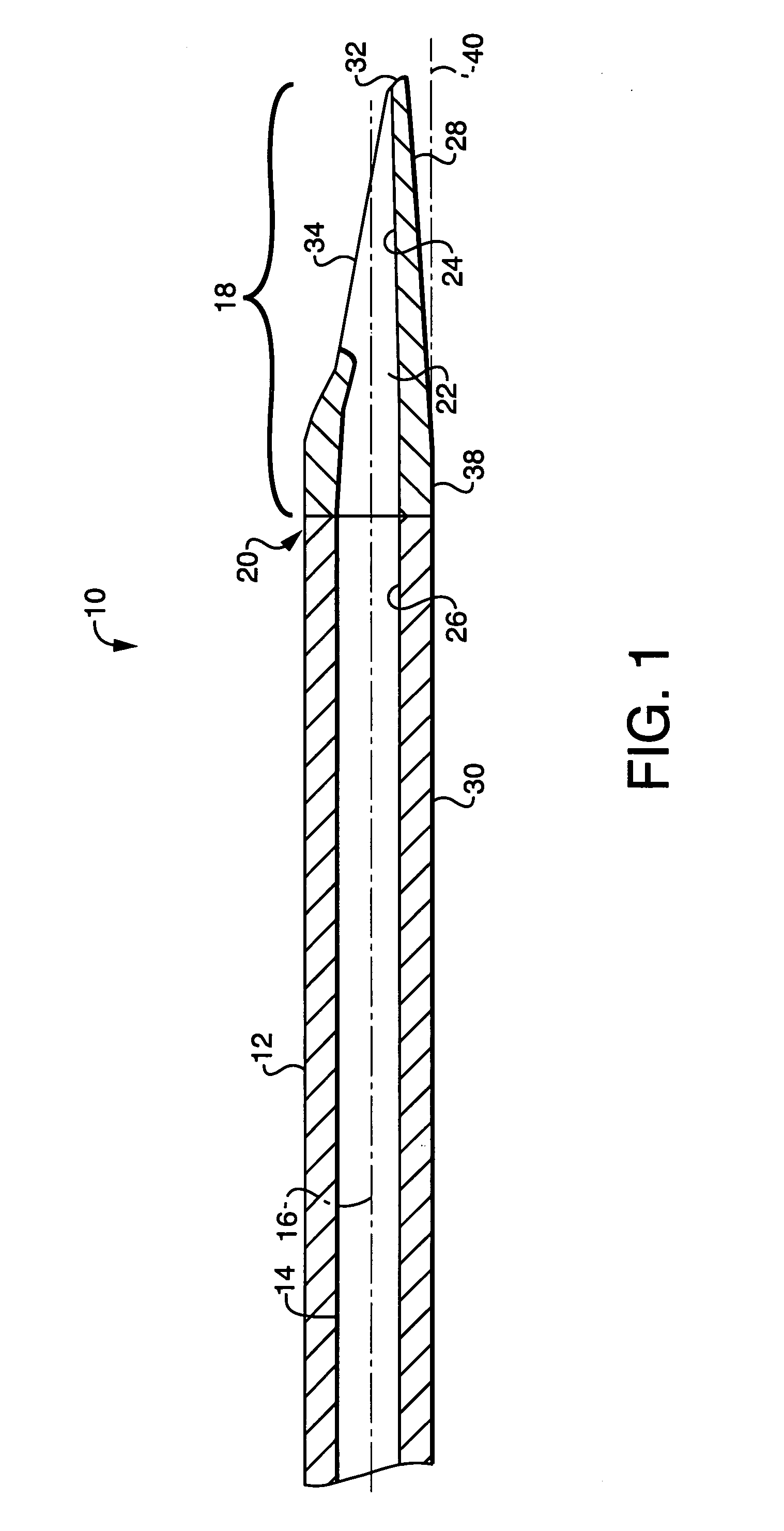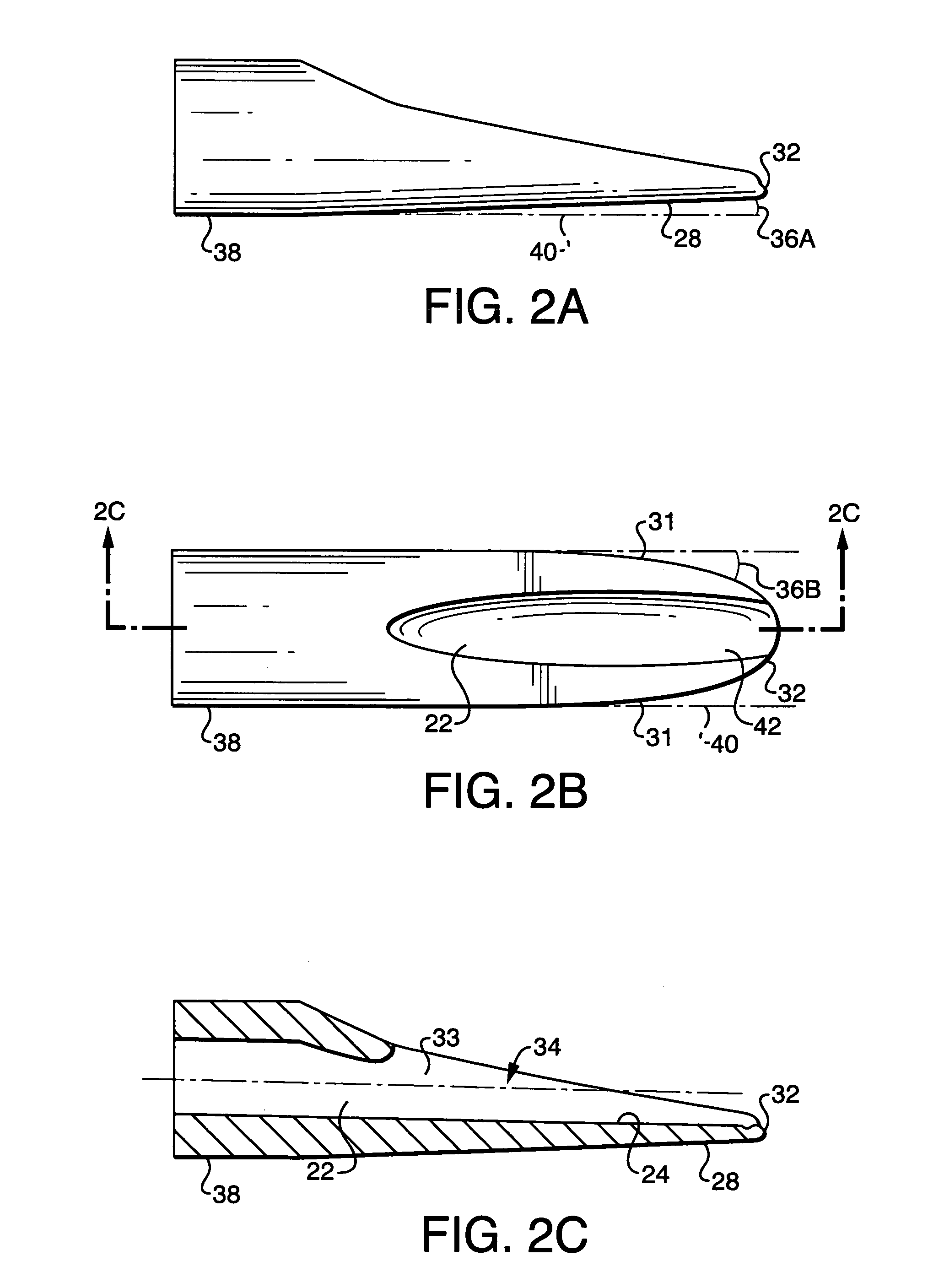Catheter introducer
- Summary
- Abstract
- Description
- Claims
- Application Information
AI Technical Summary
Benefits of technology
Problems solved by technology
Method used
Image
Examples
embodiment 44
[0037]As shown in FIGS. 2A–2C, this embodiment includes a channel 42 formed between the lower interior surface 24 which extends from the proximal end 38 of the head portion 18 to the tip 32 and interior sidewalls 33 and which, by the nature of the interior surface of the lumen, is concave around the longitudinal axis. The catheter rides within this channel as it is directed out of the opening 34 and through the duct. FIGS. 3A–3C show another embodiment 44 of the straight head portion 18. This embodiment is similar to that shown in FIGS. 2A–2C, with the exception that the channel 22 terminates at a lip 46a of the tip 32. In this embodiment, lip 46a is formed to be continuous with exterior portion 48 of the head portion.
[0038]Shown in FIGS. 4–7 are various configurations of the lip 46. Each configuration is advantageous in enabling the surgeon to insert the tip and head portion into the incision in the cystic duct and through the valves and other obstructions in the duct that may be e...
embodiment 60
[0039]In another embodiment of the present invention, the head portion may be curved with respect to the longitudinal axis to enable the interior surface of the head portion to impart a deflecting force on the catheter as it is directed through the head portion and beyond the opening therein. FIGS. 8A–8D show such an embodiment 60, wherein FIG. 8A is a side view of the head portion 60, FIG. 8B is a top view of the head portion, FIG. 8C is a cross-sectional view of the head portion 60, taken along line 8C—8C in FIG. 8B and FIG. 8D is a three-dimensional perspective view of the head portion 60. As shown in FIGS. 8A–8D, head portion 60 is generally spoon-shaped, wherein interior surface 62 and the exterior surface 64 are curved upwardly with respect to the longitudinal axis 16. The combination with sidewalls 66 and interior surface 62 result in a channel 68 that is concave in two-dimension, both along the longitudinal axis 16 and around it. This feature is particularly shown in FIG. 8D...
embodiment 90
[0043]In yet another embodiment of the present invention, the head portion may be curved with respect to the longitudinal axis to enable the interior surface of the head portion to impart a deflecting force on the catheter as it is directed through the head portion and beyond the opening therein, however, with shallower side walls and a lower profile than the spoon-shaped head portion described above. FIGS. 12A–12D show such an embodiment 90, wherein FIG. 12A is a side view of the head portion 90, FIG. 12B is a top view of the head portion 90, FIG. 12C is a cross-sectional view of the head portion 90, taken along line 12C—12C in FIG. 12B and FIGS. 12D and 12E are three-dimensional perspective views of the head portion 90. As shown in FIGS. 12A–12E, head portion 90 is generally scoop-shaped, wherein interior surface 92 and the exterior surface 94 are curved upwardly with respect to the longitudinal axis 16. The combination of shallow sidewalls 96 and interior surface 92 result in a c...
PUM
 Login to View More
Login to View More Abstract
Description
Claims
Application Information
 Login to View More
Login to View More - R&D
- Intellectual Property
- Life Sciences
- Materials
- Tech Scout
- Unparalleled Data Quality
- Higher Quality Content
- 60% Fewer Hallucinations
Browse by: Latest US Patents, China's latest patents, Technical Efficacy Thesaurus, Application Domain, Technology Topic, Popular Technical Reports.
© 2025 PatSnap. All rights reserved.Legal|Privacy policy|Modern Slavery Act Transparency Statement|Sitemap|About US| Contact US: help@patsnap.com



